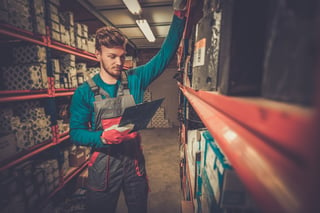 Having operated a technology business for twenty-five years, I’ve come to appreciate the importance of innovating and reinventing yourself every so often. We live in a time of continuous market disruption. All businesses (yours as well as ours) must evolve to respond to new challenges, grow, and thrive—and distributors are no exception.
Having operated a technology business for twenty-five years, I’ve come to appreciate the importance of innovating and reinventing yourself every so often. We live in a time of continuous market disruption. All businesses (yours as well as ours) must evolve to respond to new challenges, grow, and thrive—and distributors are no exception.
Moreover, it’s our responsibility as business leaders to identify and execute on new opportunities as they present themselves.
Change isn’t easy. It’s a learning process, and all organizations (including distributors) have cultural impediments that can stand in the way. It’s our job to make sure change happens—and that that change is for the better.
To illustrate my point, let’s compare the ordering cycles and distribution management methods of a distributor stuck in 1999 against its 21st-century equivalent, which I like to call “Distributor 2.0”:
The 20th-Century Order Cycle (distribution like it’s 1999)
1. Orders can come in through only a few channels:
- The customer may call or fax in an order.
- An outside salesperson may take an order on his route, calling or faxing the information into the sales department at the first opportunity. When not taking orders, the sales staff is expected to call on new prospective customers.
- In all these cases, an inside salesperson or customer service representative keys in order information by hand.
2. Each order must be checked for good credit and reviewed for product availability.
- If the order passes both tests, someone instructs the system to print a pick ticket in the warehouse.
- But if there’s a credit problem, then the order goes to the credit manager’s inbox awaiting his disposition.
- And if an item isn’t in stock, then it’s placed on backorder.
- All of these actions are time-consuming, manual processes that slow down the order fulfillment process.
3. The warehouse manager checks the printer for new pick tickets periodically during the day.
- If he finds one, he hands it to a picker.
4. The picker searches around the warehouse for all the items on the pick ticket.
- He compares the item numbers to make sure they match so he doesn’t accidentally pull the wrong product.
- That’s a common problem when a warehouse has a lot of inventory turnover, or a lot of product that looks alike. Moreover, units of measure sometimes get mixed up—for instance, a picker may pick a case instead of individual pieces.
5. The picker collects all the products along with the pick sheet in a tote.
- He brings the tote to the packing and shipping area. There, the order is placed in a queue with other orders to be packed.
6. After packing, a shipper weighs the order.
- He enters it in the UPS system, which calculates the cost and prints a label that is affixed to the box.
- The shipper then hand-enters the order shipping information (including the cost from the UPS system) into the ERP system.
7. And remember that backorder from Step 2?
- An expediter checks a backorder list daily to see if backordered products have come in.
- If they have, he prints the pick tickets, and resumes the process from Step 3 above.
See the top 3 findings from the "Innovation in Distribution" survey.
The 21th Century Order Cycle (Distributor 2.0)
1. Distributor 2.0 accepts orders through many, many more channels. They may have B2B and B2C websites, and may also sell through Amazon and eBay. Their largest customers, which include a number of big box retailers, place orders through EDI if they don’t use their website. Their inside sales team is about half the size of what it was in 1999—yet they do 3-4 times the order volume today.
- Distributor 2.0 still has an outside sales team calling on some of their most important customers, but the team is fewer in number now. Instead of writing down orders on paper forms, each carries an iPad tablet and enters the order online while checking credit and price and availability. If the customer has credit issues, the rep can swipe a credit card to tender the order, or collect a check on the spot. The rep may also suggest additional products the customer might want to buy based on recent order history.
- The sales staff still calls on prospects, but Distributor 2.0 uses CRM to leverage eMarketing and social media for demand generation in the early stages of courting a customer.
- For some customers, Distributor 2.0 provides a VMI (vendor managed inventory) service, by which they count the inventory of the products sold to the customer and generate an order to replenish, which the customer signs electronically.
2. Each order passes through an ERP system and is automatically rechecked for credit and availability.
- Neither is usually a problem, because those issues were identified at the ordering source. The ERP then automatically drops the order to a WMS (warehouse management system).
3. The WMS has predefined rules for assigning order picking.
- The assigned picker receives the order and instructions on his handheld scanner. He doesn’t have to speak with anyone to know what to do or where to find items.
 4. Warehouse inventory placement has been optimized by the WMS, based on product movement.
4. Warehouse inventory placement has been optimized by the WMS, based on product movement.
- A combination of zone and wave picking improves productivity. The system tells the picker where to find each product. He scans the bin and product bar code for accuracy and places it in a tote.
- The kicker: Distributor 2.0 employs the same number of warehouse people today as in 1999, when they did a fourth of the order volume.
5. The order is packed and passed to shipping, which scans the order number into a shipping system.
- The system rate-shops for the best shipping method, calculates the charge and passes it to the ERP system.
- The ERP automatically adds a 15% upcharge on shipping, which helps the bottom line.
- It also sends the customer an email notification that his order has shipped.
6. Back in receiving, several receivers are assigned to each container, processing the new inventory in a fraction of the time it took in 1999.
- If backordered product comes in, receivers are alerted and they cross-dock the product straight over to shipping, who can ship it out fast. Cross-docking saves time, and the customer gets his order a day earlier.
Which distributor are you?
Now ask yourself: Which scenario best describes how you operate? And which do you think is the better model for a distribution enterprise that wants to grow?
If you’re solidly in the 21st-century model, congratulations! You’ve embraced technologies and methods that are making your operations more efficient, making your business more competitive, and making your customers happier.
If not, it may be time to look at new systems and get a plan in place to transform your organization into Distributor 2.0. You’ll add value to your business, preserve its longevity, gain competitive advantage, and make more money.
This article is the first in a series that will focus on transforming your supply chain business. Feel free to contact us anytime, or request the free “Guide to Wholesale Distribution Software.”





